Who wouldn’t crave a spoonful of warm, silky Atta Halwa, brimming with the goodness of ghee and a comforting, nutty aroma that lingers in the kitchen air? This traditional Indian sweet delivers pure comfort in every bite with its smooth, rich texture and balanced sweetness.
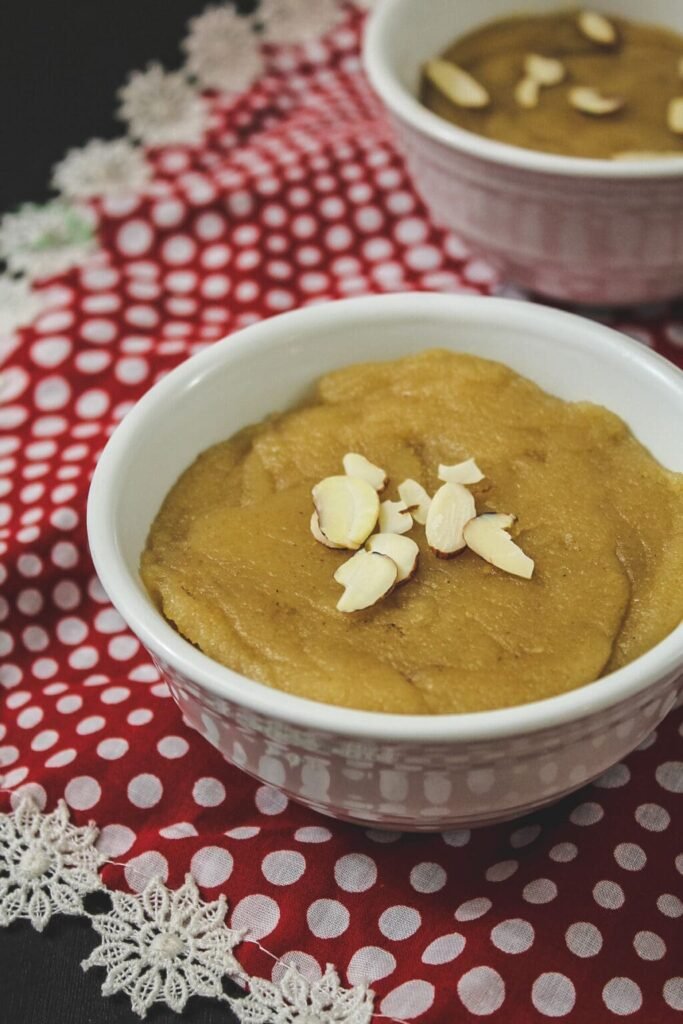
Made with just four pantry-friendly ingredients—whole wheat flour (atta), ghee, sugar, and water—this dessert is a testament to the magic of simplicity. Often topped with finely sliced almonds or crunchy cashews, it adds a delightful contrast to the halwa’s smooth, melt-in-the-mouth texture.
Atta Halwa means wheat-based dessert. Punjabis call it Aate Ka Halwa, while Gujaratis know it as Gau No Sheero.
While recipes might vary slightly from one region to another, the soul of the dish remains the same: a golden, aromatic halwa that soothes the heart and satisfies the soul. Roasting the flour patiently in ghee is the key—it imparts a deep, nutty aroma that forms the foundation of this dish’s flavor. Once the sugar syrup is added, the mixture transforms into a luscious, glossy halwa that’s perfect for any celebration or simple indulgence.
Whether served warm during festivals like Navratri and Diwali or offered as prasad in temples, Atta Halwa holds a special place in Indian kitchens, both for its cultural roots and irresistible taste.
You’ll Love This Atta Halwa Recipe
Who wouldn’t crave a spoonful of warm, silky Atta Halwa, brimming with the goodness of ghee and a comforting, nutty aroma that lingers in the kitchen air? This traditional Indian sweet delivers pure comfort in every bite with its smooth, rich texture and balanced sweetness. Made with just four pantry-friendly ingredients—whole wheat flour (atta), ghee, sugar, and water—this dessert is a testament to the magic of simplicity. Often topped with finely sliced almonds or crunchy cashews, it adds a delightful contrast to the halwa’s smooth, melt-in-the-mouth texture.
The term “Atta Halwa” refers to the wheat-based nature of the sweet (since atta is the Hindi word for whole wheat flour). Punjabi households fondly call it Aate Ka Halwa and often prepare it during religious offerings, festive celebrations, or to satisfy sudden sweet cravings. In Gujarati cuisine, this same dish goes by the name Gau No Sheero, often enriched with milk and flavored with cardamom or nutmeg, making it slightly more decadent.
While recipes might vary slightly from one region to another, the soul of the dish remains the same: a golden, aromatic halwa that soothes the heart and satisfies the soul. Roasting the flour patiently in ghee is the key—it imparts a deep, nutty aroma that forms the foundation of this dish’s flavor. Once the sugar syrup is added, the mixture transforms into a luscious, glossy halwa that’s perfect for any celebration or simple indulgence.
Whether served warm during festivals like Navratri and Diwali or offered as prasad in temples, Atta Halwa holds a special place in Indian kitchens, both for its cultural roots and irresistible taste.
Ingredients For Aate Ka Halwa:
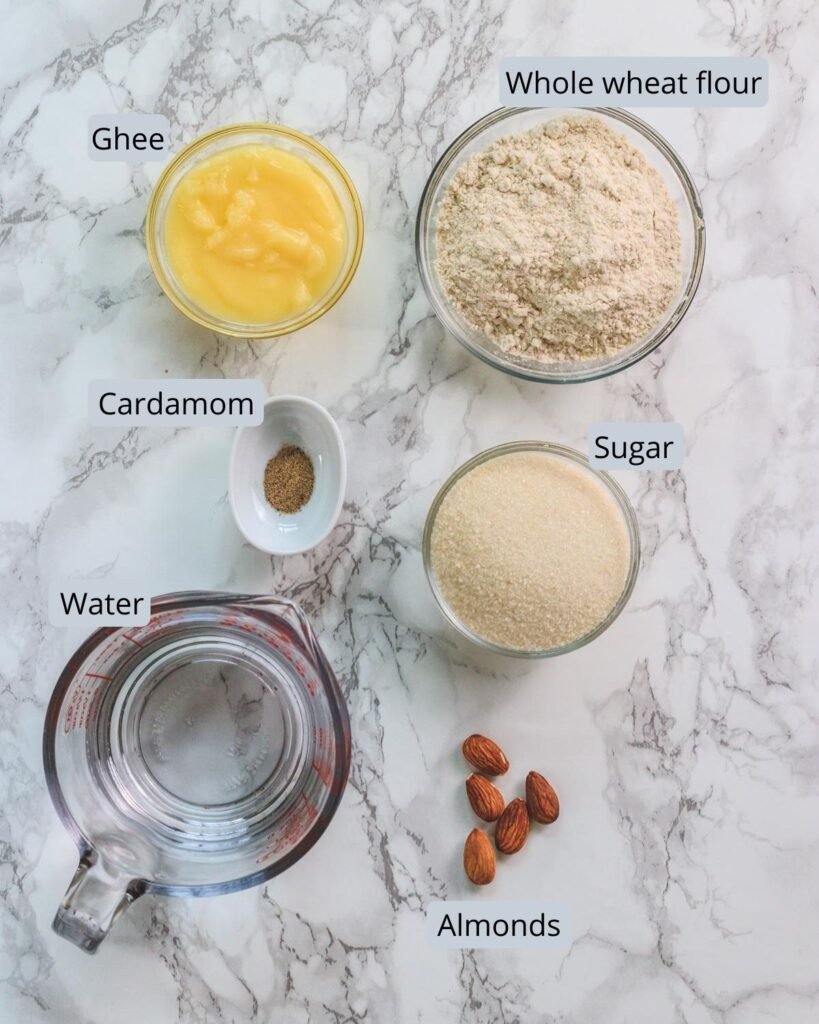
1. Ghee: Ghee is the heart of atta halwa—its quality can make or break the dish. I always opt for homemade ghee, as it lends a rich aroma and elevates the flavor beautifully. Ghee not only lends the halwa its signature glossy texture but also prevents the flour from clumping during roasting. Avoid cutting down the ghee—a lesser quantity can alter both the texture and taste, making the halwa dry or gritty instead of smooth and luscious.
2. Whole Wheat Flour (Atta): For this recipe, I always go with whole wheat flour, commonly known as chapati atta, which is easily available at any Indian grocery store. It has the right texture and flavor profile needed for traditional Indian sweets. I haven’t tried this recipe with whole wheat flour from Western supermarkets, so results may vary. Indian atta imparts the signature nutty fragrance and smooth, velvety texture that truly defines an authentic and delicious halwa.
3. Sugar (or Jaggery): Sugar is the conventional sweetener used in atta halwa and works beautifully to balance the rich flavors of roasted flour and ghee. For a healthier option, swap sugar with jaggery. If using jaggery, make sure to melt it first in warm water, then strain it to remove any impurities before adding it to the roasted flour. This variation not only adds a depth of earthy sweetness but also makes the dessert more nutritious, perfect for toddlers or those looking for a refined sugar-free option.
How To Make Atta Halwa?
1) Begin by gently warming ghee in a heavy-bottomed pan over a medium to low flame. This type of pan ensures even heat distribution, which helps prevent the flour from sticking to the bottom or burning while it roasts. Let the ghee melt slowly and warm up—this forms the rich base of your halwa.
2) As the ghee heats up and releases its signature nutty fragrance, stir in the whole wheat flour and begin roasting. Use a sturdy wooden spatula or a heat-safe silicone spoon to mix. Initially, the mixture will feel heavy, dense, and slightly lumpy, making it a bit tough to stir—but that’s completely normal at this stage.
3) Stir the flour continuously to roast it evenly in the ghee. Initially, the mixture will appear lumpy and heavy, but don’t worry—that’s normal. Keep stirring patiently and make sure no part of the flour sticks to the bottom.
4) Continue roasting until the flour changes color slightly and a toasty, nutty aroma fills the kitchen. You’ll notice the flour becomes lighter in texture and more paste-like. The ghee will start separating and oozing out at the edges—this is the key sign that the flour has roasted perfectly.
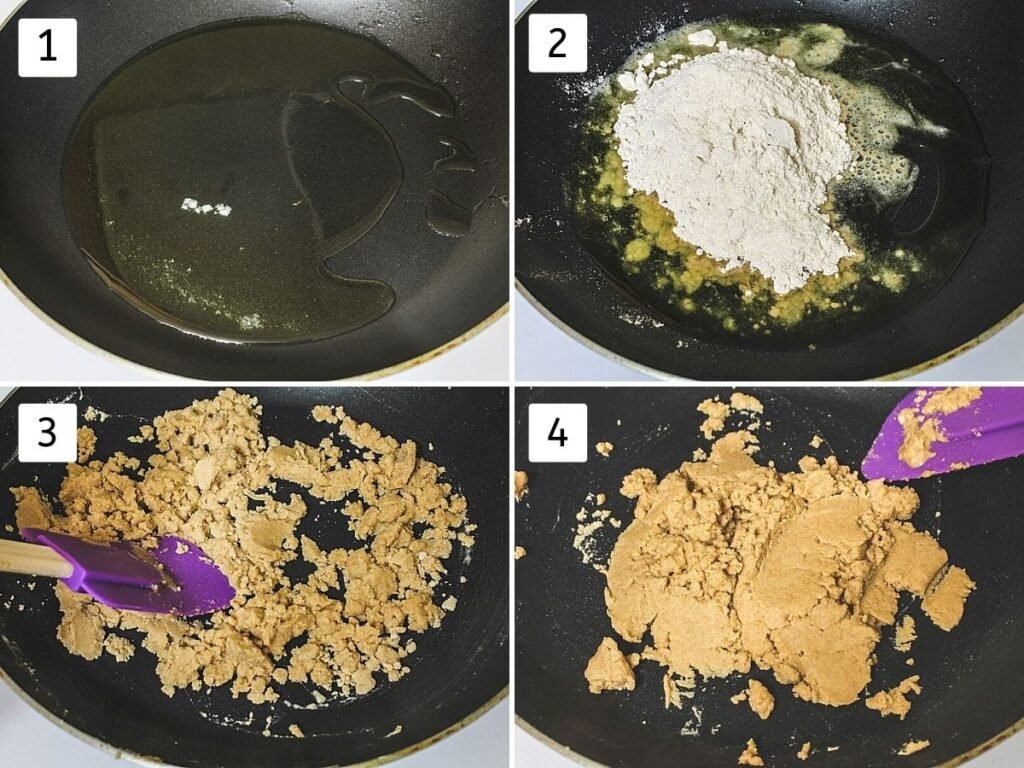
5) Now, carefully pour in warm water while stirring with your other hand. This step is crucial—adding water while stirring continuously prevents lumps from forming and ensures a smooth texture.
6) Continue cooking and stirring for 2–3 minutes. The mixture will quickly absorb all the water and begin to thicken. Keep stirring continuously to maintain a smooth, lump-free texture and ensure the mixture stays silky and uniform throughout the roasting process.
7) Add sugar at this stage and mix thoroughly. As the sugar dissolves, the halwa will loosen up and become a bit runny again—this is completely expected.
8) Keep stirring and cooking on medium-low heat. As you continue stirring, the halwa will gradually thicken again and start to pull away from the sides of the pan, indicating it’s nearly done. The ghee will again release and pool around the edges.
9) Turn off the heat when the halwa reaches a rich, glossy consistency and pulls together into a soft mass. It should no longer stick to the pan and should have a beautiful golden hue.
10) Complete the halwa by sprinkling in the cardamom powder and mixing it thoroughly. This final addition imparts a comforting, aromatic sweetness. Serve the atta halwa warm, garnished with slivered almonds or cashews for an added crunch and visual appeal.
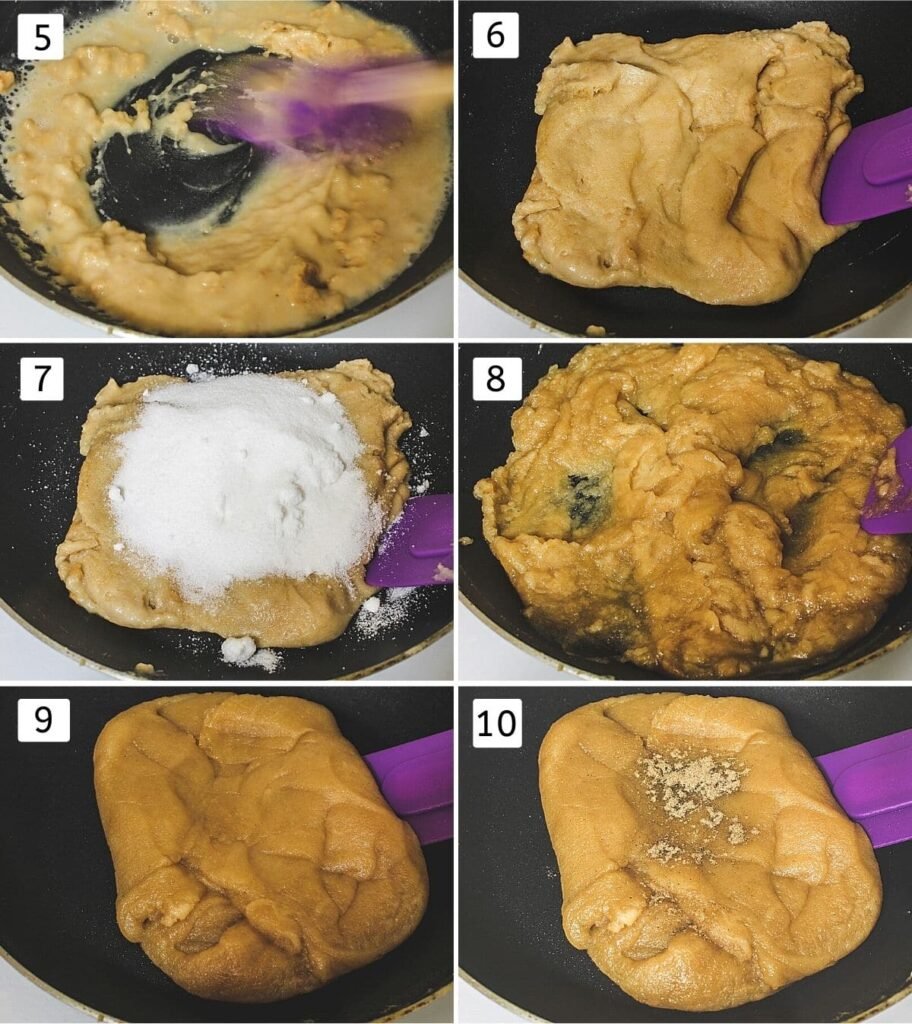
Expert Tips For Wheat Halwa
1) Always Use a Heavy-Bottomed Pan:
Begin with a sturdy, thick-bottomed kadai or pan. This is essential to prevent the flour from scorching or browning too fast before it has had a chance to roast properly. Even heat distribution is key in achieving that deep, nutty flavor without burning.
2) Roast on Medium-Low Heat:
Set your flame to medium-low and let the ghee heat up gently. Once it’s warm and aromatic, add the whole wheat flour. Roasting on low heat allows the flour to cook gradually, ensuring it doesn’t retain any raw taste.
3) Stir Constantly:
Keep stirring nonstop from the moment you add the flour. The mixture will initially feel heavy, thick, and slightly lumpy. It may seem like a workout, but the consistent stirring helps the flour cook evenly. Consider it your arm-toning bonus while making dessert!
4) Watch for the Signs of Perfect Roasting:
As the flour roasts, it will undergo a visible transformation. It will feel lighter while stirring, turn from clumpy to a smooth, paste-like consistency, and develop a golden hue. More importantly, a rich, toasty aroma will fill the kitchen — this is your signal that the flour is perfectly roasted.
5) Optional – Fry Nuts Beforehand:
If you plan to add nuts like cashews or almonds, fry them in ghee at the beginning and then set them aside. Add these golden beauties back in once the halwa is ready. This keeps them crunchy and prevents overcooking.
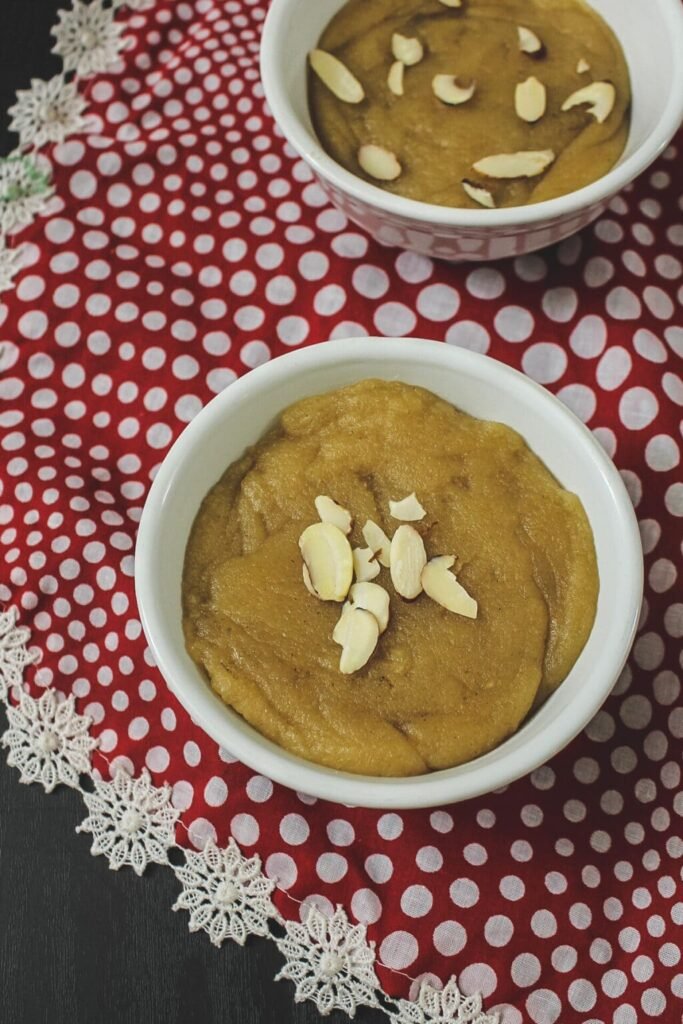
Serving Ideas For Atta Halwa
1) Serve It Warm or at Room Temperature:
Atta Halwa tastes best when served warm, as the ghee remains slightly molten, giving it a luscious, silky texture. However, it also holds up well at room temperature, especially during festive gatherings or poojas when it’s made in advance.
2) Enjoy as a Traditional Breakfast (North Indian Style):
In many North Indian households, particularly during special occasions or religious days, atta halwa is part of the breakfast table. It’s served steaming hot, sometimes with a side of savory snacks like chana (black chickpeas) for a wholesome start to the day. The richness of the halwa, combined with its energy-boosting ingredients, makes it a comforting and hearty morning meal.
3) Serve as a Classic Indian Dessert:
This sweet treat easily doubles up as a dessert after lunch or dinner. Its nutty aroma, rich ghee flavor, and melt-in-the-mouth texture make it a delightful end to any traditional meal. You can enhance its visual appeal and taste by garnishing it with roasted nuts like almonds, cashews, or even golden raisins.
4) Pair with Puri for a Festive Meal:
One of the most beloved combinations in Indian cuisine is hot atta halwa paired with crispy puris. This duo is often served during festivals, religious ceremonies, and special family gatherings. The contrasting textures — soft, sweet halwa and crisp, fried puris — create a satisfying balance that’s both indulgent and nostalgic.
